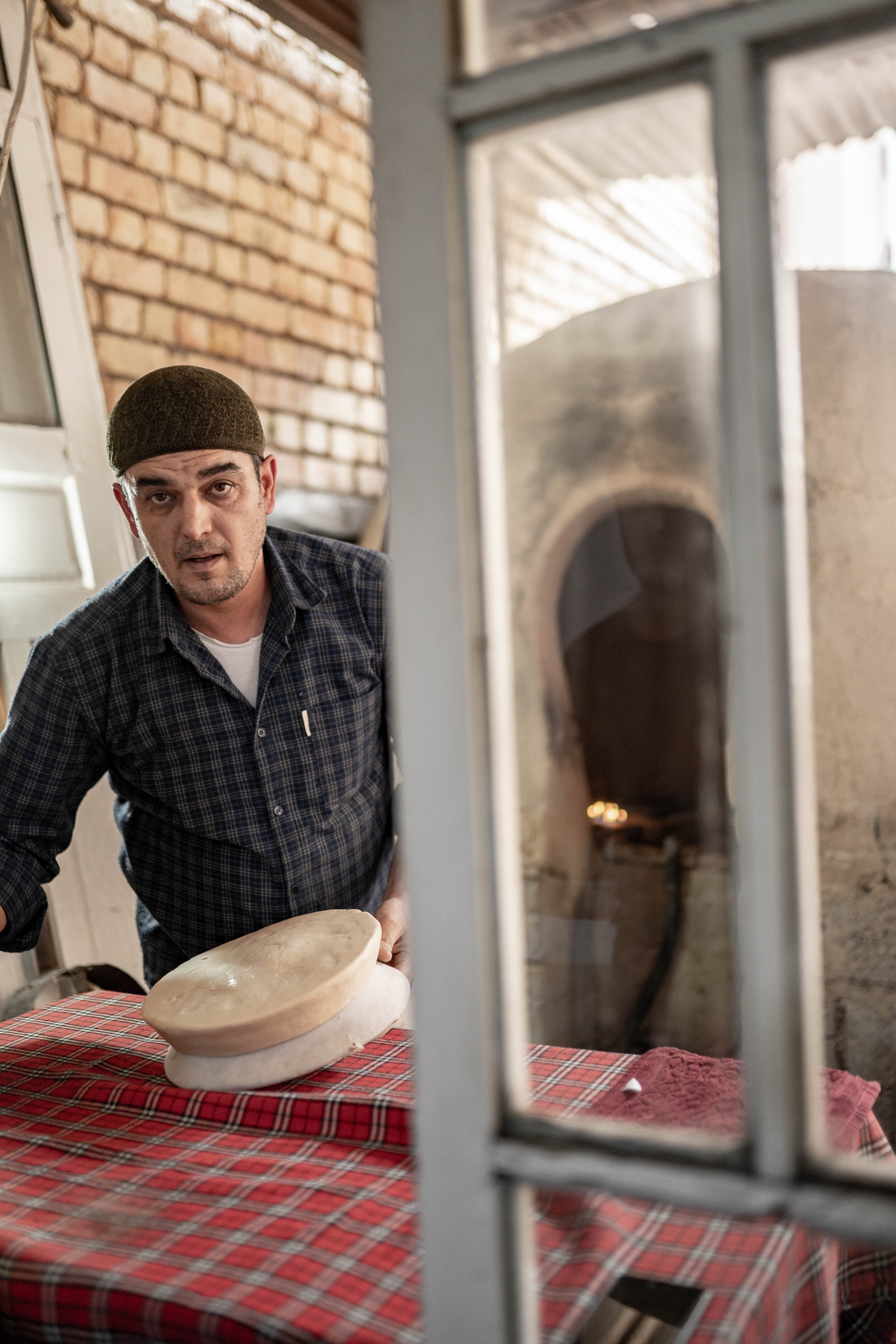Samarkand bread baker
By: Sabina Odinayeva
Photos: Feruz Rustamov
Bread is one of the symbols of Samarkand. Uzbek loaves come in different types and sizes, each distinguished by unusual decorative patterns and unique taste. In Samarkand and in general throughout Uzbekistan, bread is revered. Numerous traditions dictate how and when to eat bread: for example, it is considered disrespectful to lay a loaf face down or to cut it with a knife. Long ago, it was a national tradition to carry a loaf on the head, which signified respect and reverence for bread. In some families, this tradition is still preserved, such as the family of baker Asliddin Khasanov.
Khasanov specialises in making heavy and nourishing Samarkand breads. These are medium-sized loaves with sesame seeds in the middle, baked in special tandoors. The tandoor is a boiler-shaped stove with clay-lined walls. The bread sticks to the walls and absorbs the oven’s heat, giving the loaf a ruddy colour and soft inner texture. If one of the loaves happens to from the wall into the ash while baking, it is considered sacred.
The history of Asliddin Khasanov’s family bakery began with his grandfather, who began the tradition of baking Samarkand bread, one which his son continued. Asliddin himself has been making bread since 1991 – over 30 years.
“I started baking on my own at the age of 14. That day my father died, and before his death, early in the morning, he kneaded the dough and so that the dough would not go to waste, I had to bake all bread.”
The working day of the Khasanov’s family begins at three o'clock in the morning. If they start baking at this time, then by 9am, the first batch of fresh bread is ready. Bread is prepared five to six times a day, depending on how many orders are received. Customers usually order their bread a day in advance, so the family knows how much to make. They spend all day baking until 5-6pm.
Asliddin Khasanov has five children – three sons and two daughters. The two eldest sons, Ibrohim and Normurod, help their father with the cooking process, while his wife and daughters help decorate the loaves, and their grandmother sells ready-cooked bread in the bazaar.


Khasanov explains why breadmaking has traditionally been a male-dominated profession: “For the baking of Samarkand bread, the work of male hands is desirable. When you knead dough, you need strength. Well, according to tradition, only men were involved in making bread.”
And Khasanov says there are many legends about Samarkand bread.
Once the khan of Bukhara asked his advisers why bread was brought from Samarkand to Bukhara, if it could be baked in Bukhara. He was told that only bread baked in Samarkand would be tasty, but the khan did not believe the advisers and ordered them to bring Samarkand bread to Bukhara. The order was executed. The khan sent people to Samarkand to find the best breadmaker in the city and ordered him to bake bread in Bukhara. But the bread still didn't work out as it should. The advisers thought hard and racked their brains, and decided that the reason was because of the ingredients. They brought a tandoor from Samarkand, along with flour, water and absolutely everything that was required, but even then, the bread did not turn out the same as in Samarkand. Then the master said: ‘It’s probably in the air.’ However, the air could not be transported, so soon he was allowed to return home, and people began again, as before, to carry bread from Samarkand.
“There is no secret ingredient in Samarkand bread. We make it from flour, yeast, water and salt. It all depends on the method of cooking and, of course, the love put into this bread,” says Khasanov.
Samarkand even has a ‘bread season’. Known as the ‘sales season’, it starts in spring and lasts until the end of summer. This is the time when demand for bread is high and bakeries are busy baking for events (weddings, celebrations, spring holidays). Also, at the beginning of spring, Samarkand begins to overflow with a large number of tourists and travellers, which adds to a need for more bread.
Every guide from Samarkand knows the house of Asliddin Khasanov the baker. Tourists visit the bakery with great interest, watching the process of making a crispy, steaming Samarkand loaf. The moment of greatest joy is in taking a delicious piece of Samarkand home to share it with loved ones.
Breaking bread is like touching the history of the city, because the recipes have been used for centuries. This bread is famous for its taste and special properties that mean it does not harden for a long time. A real Samarkand loaf, kept at room temperature, can be saved and eaten for up to 10-14 days. Put it in the fridge and it can be stored for two to three months.
According to another legend, the bread was made to be long-lasting so that soldiers could take it with them on campaigns. The bread never became mouldy, and all that was needed was a sprinkle of water before reheating and the loaves would regain their original shape and freshness.
It is a special mission for Asliddin Khasanov’s children to continue the family tradition. After all, baking real Samarkand bread is a serious and hungry business.






